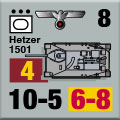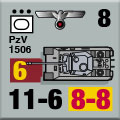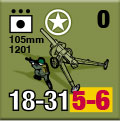| Dragon’s Teeth:
Scenario Preview, Part Five
By Mike Bennighof, Ph.D.
April 2024
 There’s an aspect of the military history of the Second World War that I don’t think gets enough attention, even today: By the last months of 1944, the U.S. Army had become very good at making war. They had plenty of material advantages, but they’d learned how to use them, and now proceeded to chew up the vaunted German Army. There’s an aspect of the military history of the Second World War that I don’t think gets enough attention, even today: By the last months of 1944, the U.S. Army had become very good at making war. They had plenty of material advantages, but they’d learned how to use them, and now proceeded to chew up the vaunted German Army.
Panzer Grenadier: Dragon’s Teeth pits this experienced American force against a revived German Army in the Siegfried Line campaign of late 1944. The Americans almost always have strong morale, initiative, and leadership (the crucial elements in Panzer Grenadier) plus advantages in armor and artillery. The Germans usually bring better toys, when they have them at all, and their best units are indeed very good. But so are the best American divisions.
For the most part, it’s an even fight. The Germans have fortifications and dense terrain to balance out their weaknesses. The result is a brutal, close-quarters fight with plenty of armored action. Let’s have a look at the fifth chapter.
Chapter Five
Smashing the Crust
After four days of intense combat, the Americans had finally shown some results despite tenacious German resistance and atrocious weather. The Germans had held the American advance in the dense Hürtgen Forest, but just to the north the terrain opened up toward the Indie and Roer rivers. With just one or two days of good weather, American VII Corps commander “Lightning Joe” Collins believed, “the crust could be smashed.”

A 22nd Infantry Regiment mortar team in the ruins of Grosshau, Germany.
To smash the crust, he had the veteran 1st Infantry Division, reinforced with another regiment from 9th Infantry Division, plus the crack 3rd “Spearhead” Armored Division and the 104th Infantry Division, performing well in its first taste of major combat. His other two divisions, the 4th and 28th Infantry, had been chewed up in the fierce fighting within the Hürtgen Forest and this time even the arrival of thousands of poorly-trained but willing replacements couldn’t make good their combat power – so many junior officers and NCO’s had been killed or wounded that the new men simply couldn’t be absorbed and acclimated to combat conditions.
While the Germans were no better off and by many measures in worse condition, they still mounted determined resistance. Their supply lines had been shortened, and they now fought on German soil, in the first and still only place where Germany’s borders had been violated. It would not be so easy to smash this crust.
Scenario Thirty
“We Need Heistern”
20 November 1944
 All the previous day, the battered 104th Grenadier Regiment had fought to deny the Americans the key village of Heistern. Whoever controlled the village also controlled the valley beyond, with unimpeded observation all the way to Langerwehe. “We need Heistern, before we can go anywhere,” officers of the U.S. 16th Infantry Regiment told their men. On the other side, knowing his regiment would never stand another day’s fighting, shortly after midnight Colonel Josef Kimbacher personally led his survivors against the Americans encircling them to the north. All the previous day, the battered 104th Grenadier Regiment had fought to deny the Americans the key village of Heistern. Whoever controlled the village also controlled the valley beyond, with unimpeded observation all the way to Langerwehe. “We need Heistern, before we can go anywhere,” officers of the U.S. 16th Infantry Regiment told their men. On the other side, knowing his regiment would never stand another day’s fighting, shortly after midnight Colonel Josef Kimbacher personally led his survivors against the Americans encircling them to the north.
Conclusion
The German regiment had already been reduced in strength to less than a battalion, and American firepower reduced it further: the Germans left at least 250 dead strewn about the village, and the Americans took another 120 prisoners, including the colonel. Within a few hours the Americans had taken the rest of Heistern, as Kimbacher’s foolish attack – fairly typical for the German forces trying to hold on in the Rhineland – had destroyed the forces that could have held the place.
Notes
It’s a German night attack, against well-prepared Americans with superior morale and leadership. The Germans have numbers and artillery, for once, on their side; they also have a tiny bit of armor support. It’s still a tough task for the German side.
Scenario Thirty-One
Road X to Grosshau
20 November 1944
 While two of 4th Infantry Division’s regiments made good progress, some accurate German long-range artillery fire interrupted the flow of supplies to the division’s 22nd Infantry Regiment. That slowed their advance down the route labeled “Road X” on American situation maps, a narrow forest road leading to Grosshau, the regiment’s objective. That delay allowed the Germans to rush a depleted division northward to plug the gap in their lines before the Americans could burst through. While two of 4th Infantry Division’s regiments made good progress, some accurate German long-range artillery fire interrupted the flow of supplies to the division’s 22nd Infantry Regiment. That slowed their advance down the route labeled “Road X” on American situation maps, a narrow forest road leading to Grosshau, the regiment’s objective. That delay allowed the Germans to rush a depleted division northward to plug the gap in their lines before the Americans could burst through.
Conclusion
Spearheaded by armor, the veteran German 275th Infantry Division counterattacked the Americans as soon as they broke into the clear. With only bazookas to combat the assault guns, half of G Company became casualties including all the officers. First Battalion fared better against the newly arriving People’s Grenadiers, taking Hill 136 before fighting off a counterattack. They spent the rest of the day clearing half-trained, dispirited German soldiers north of the road from their bunkers.
Notes
The Americans open the action on the attack, only to be met by a German counter-attack spearheaded by a few (a very few) assault guns. The Americans have a healthy edge in numbers, morale and artillery; the Germans will have to use that tiny armored component wisely.
Scenario Thirty-Two
Tusk Hogs
22 November 1944
 Despite wretched weather including heavy rain, the 30th Infantry Division ordered its 120th “Tusk Hogs” Infantry Regiment to press forward and capture the village of Lohn. The Germans holding the town had suffered heavy casualties and radio intercepts included repeated calls for reinforcements; the division staff hoped to seize the town before any fresh troops arrived. The North Carolina Guardsmen would have to hurry to root out the Germans. Despite wretched weather including heavy rain, the 30th Infantry Division ordered its 120th “Tusk Hogs” Infantry Regiment to press forward and capture the village of Lohn. The Germans holding the town had suffered heavy casualties and radio intercepts included repeated calls for reinforcements; the division staff hoped to seize the town before any fresh troops arrived. The North Carolina Guardsmen would have to hurry to root out the Germans.
Conclusion
The Americans worked their way steadily towards Lohn until three tanks occupying some high ground brought their progress to a halt. The accompanying tank destroyers proved incapable of dislodging them, but eventually the German tanks left and the American advance continued. Upon reaching Lohn some German tank destroyers “caused considerable trouble” against the American flank, and with the enemy still occupying part of the town things were far from secure when the action stopped for the night.
Notes
The Americans are on the attack, with tank support and plenty of artillery, but they face muddy ground and a stout defense, also supported by armor. They have a lot of ground to cover, and that won’t be an easy task.
Scenario Thirty-Three
Chickenshit Regulations
23 November 1944
 Terry de la Mesa Allen had been fired as 1st Infantry Division commander in 1943, for failure to instill what corps commander Omar Bradley called “discipline” and Allen termed “chickenshit” regulations. Allen’s boasts about the abilities of his new 104th Infantry Division won him no friends among his fellow generals. But he had trained his men hard, and got immediate results with his formula of maximum aggression and minimum friendly casualties. Terry de la Mesa Allen had been fired as 1st Infantry Division commander in 1943, for failure to instill what corps commander Omar Bradley called “discipline” and Allen termed “chickenshit” regulations. Allen’s boasts about the abilities of his new 104th Infantry Division won him no friends among his fellow generals. But he had trained his men hard, and got immediate results with his formula of maximum aggression and minimum friendly casualties.
Conclusion
Allen’s division made good on their commander’s boasts, securing Eschweiler and advancing rapidly along the Indie River to reach Weisweiler. There things came to a stop, as the Americans met strong resistance at the town of Pützlohn, sitting atop a dominating ridge line, and at Weisweiler, where “friendly” fire from the neighboring 30th Infantry Division’s sector stopped an advance outside the town. The 413th Infantry Regiment’s 3rd Battalion took heavy casualties at Pützlohn, including seven supporting Shermans lost.
Notes
The Americans seemingly have everything going for them: numbers, leadership, artillery. But the Germans are in a strong position, and the Americans have to achieve a lot in order to win.
Scenario Thirty-Four
Spearhead Blunted
24 November 1944
 Lightning Joe Collins ordered Maurice Rose of 3rd Armored Division to form a task force to seize the high ground around Frenzerburg, giving him an infantry battalion from the 9th Infantry Division. Rose added tanks, tank destroyers, armored artillery, and engineers, and gave Lt. Col Walter B. Richardson the task. Before he could reach the high ground, Richardson would have to get past the belt of minefields and entrenchments guarding the town of Hücheln. Lightning Joe Collins ordered Maurice Rose of 3rd Armored Division to form a task force to seize the high ground around Frenzerburg, giving him an infantry battalion from the 9th Infantry Division. Rose added tanks, tank destroyers, armored artillery, and engineers, and gave Lt. Col Walter B. Richardson the task. Before he could reach the high ground, Richardson would have to get past the belt of minefields and entrenchments guarding the town of Hücheln.
Conclusion
Hemmed in by unit boundaries to the north and forest to the south, Richardson couldn’t bypass the village. His armored engineers finally cleared a path through the thick belt of mines and assault the village, where heavy fighting developed with the Germans giving as good as they got. The Americans finally managed to secure Hücheln at 2100 that night, and did not continue the advance in the darkness.
Notes
We did a version of this battle long ago in the old West Wall scenario booklet, but the development had some problems so I gave it a pretty thorough replacement. The Americans have to slog their way through minefields and German entrenchments just to reach their objective; then they have to fight for that, too. This will not be an easy task.
Scenario Thirty-Five
Sad Results
25 November 1944
 When the 5th Armored Division launched an attack against the town of Hürtgen, Col. Buck Lanham of the 22nd Infantry Regiment saw an opportunity. His regiment would attack the objective of Grosshau, just outside the bloody Hürtgen Forest, a day early with all three battalions plus attached armored support and catch the Germans by surprise. But it took the armor an extra four hours to reach the start line, taking away any hope of a dawn surprise. When the 5th Armored Division launched an attack against the town of Hürtgen, Col. Buck Lanham of the 22nd Infantry Regiment saw an opportunity. His regiment would attack the objective of Grosshau, just outside the bloody Hürtgen Forest, a day early with all three battalions plus attached armored support and catch the Germans by surprise. But it took the armor an extra four hours to reach the start line, taking away any hope of a dawn surprise.
Conclusion
Only a handful of the tanks committed to the attack made it out the muddy forest paths, only to meet concentrated German anti-tank fire. One of Lanham’s battalions actually made some progress, but the others fell back into the forest in some disarray. By mid-afternoon the attack had clearly failed, what the U.S. Army’s official history would call “sad results,” leaving Grosshau in German hands.
Notes
The Americans have vast edges in numbers, armor, and artillery – if they can get their tanks moving. Getting that impressive array into action will not be easy, so the American player has a greater challenge than it may seem at first glance.
Scenario Thirty-Six
An Artillery War
25 November 1944
 The American November offensive saw both sides employ increasing amounts of artillery fire, but nowhere was this more evident than at Bourheim, objective of the 29th “Blue and Gray” Infantry Division. In just this sector, the Americans fired an estimated 27,500 rounds per day, while the Germans flung back just over 13,000. Into that storm of steel, a freshly-arrived German division prepared to counter-attack. The American November offensive saw both sides employ increasing amounts of artillery fire, but nowhere was this more evident than at Bourheim, objective of the 29th “Blue and Gray” Infantry Division. In just this sector, the Americans fired an estimated 27,500 rounds per day, while the Germans flung back just over 13,000. Into that storm of steel, a freshly-arrived German division prepared to counter-attack.
Conclusion
The American 3-inch anti-tank guns rushed in the previous day proved ineffective as German artillery neutralized the gun crews. Once into the town, a single German tank devastated the command post while the others spread out to wreak havoc. Frantic cries went out for bazooka teams, but those too proved ineffective against the troublesome tanks. The Americans then tried satchel charges, and that plus the fact that the enemy tanks had lost their infantry support by then convinced them to withdraw. The fighting at Koslar ended with two American companies surrounded, and it would take almost three days for the other American units to reach them.
Notes
It’s an armor-backed German attack, coming up against a stout American defense, and both sides get to blaze away with copious artillery fire. The Germans have an edge here, with plenty of force and a reasonable set of objectives.
And that’s all for Chapter Five. Next time, we wrap it up with Chapter Six.
You can order Dragon’s Teeth right here.
Sign up for our newsletter right here. Your info will never be sold or transferred; we'll just use it to update you on new games and new offers.
Mike Bennighof is president of Avalanche Press and holds a doctorate in history from Emory University. A Fulbright Scholar and NASA Journalist in Space finalist, he has published an unknowable number of books, games and articles on historical subjects.
He lives in Birmingham, Alabama with his wife and three children; he misses his dog, Leopold.
Want to keep Daily Content free of third-party ads? You can send us some love (and cash) through this link right here. |
